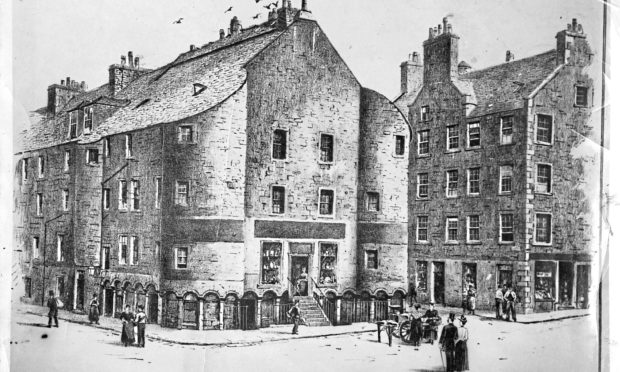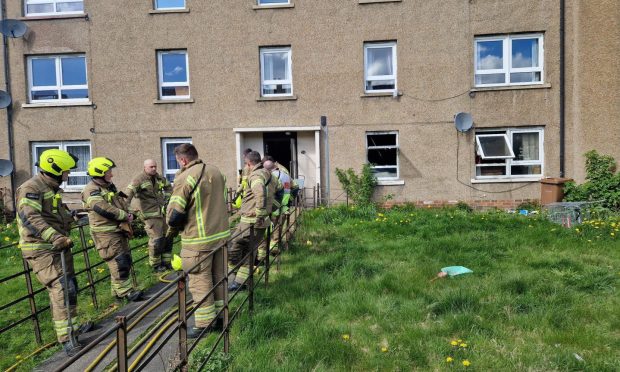It is unlikely we will ever uncover the identity of Barney but the sorrow surrounding his death at the height of the cholera outbreak of 1832 was recorded in detail by this newspaper.
A surgeon, interviewed in 1850, recalled that even in the most desperate of circumstances, the poor of Dundee acted with love and compassion towards one another.
It is tempting to imagine that at a time of high mortality, life did not command the same value we place on it in the 21st Century.
The surgeon’s account dispels that notion and his anecdotes show people acted selflessly, even when faced with great danger to themselves.
The surgeon, who was not named, told our reporter of the scene in Barney’s home. It was a bare room and in the corner was a bed of straw covered with a few rags.
Barney was a strong, muscular young man who was newly arrived in the city from Ireland with his wife and young child.
When the surgeon arrived, Barney was lying on the bed struggling with death while the cholera gnawed at him.
The couple’s only child was wrapped in a shawl and sleeping on the floor.
The young wife was leaning over her unconscious husband, careless to the danger.
The distraught young woman did not even notice the surgeon enter the room she was so focused on her love.
The surgeon observed as she twirled her husband’s hair and cried out: “Oh Barney, will you leave baby and me.”
The woman then bade farewell, howled and fell backwards.
The surgeon used Barney’s death to illustrate that young wives seemed to feel cholera deaths more acutely than others. They expressed their loss with a particular wail which the medical profession recognised.
This newspaper described life in the city during the outbreak as follows.
“Men looked more serious…and the passing to and fro of death cars at all hours impressed the mind with a feeling of awe as if it was breathing an atmosphere loaded with death and living in a city hung with a great funeral pall.”
However, even in those days of danger when fathers were snatched from their loved ones and mothers and children were hurried from their homes to the grave, a seam of care and compassion ran through the poorest districts of Dundee.
Another story of bravery recalled by the surgeon was of a woman who took in her neighbour’s children including a suckling infant.
The neighbour’s husband had been taken by the illness leaving the widow the sole protector of six children.
She took ill and was carried from her house to the infirmary but lasted just five hours.
Without hesitation the neighbour took over the care of the children including the suckling baby. The surgeon recorded her reasoning as follows: “A weel, weel, doctor, it may be a’ true but puir thing, the bairn mann by attended to and wha kens but somebody may hae to gie mine sook the morn.”
Then there were the orphan sisters who had arrived in Dundee when their farmer father died.
They lived in one of the poorest districts in humble circumstances. The girls were needleworkers and led exemplary lives. Their only frequent excursions were to church.
However, when cholera was at its most violent, the sisters mingled with the community, spending much of their time ministering to the sick.
They seemed to rise above the emergency at first but the younger was attacked by the deadly scourge.
She was taken to the infirmary but lasted only five hours before she died in the arms of her sister. As she expired the remaining sister assumed the mysterious dark hollowness which cholera produces.
She was aware time was short and walked a mile to her friend’s house and asked for paper and ink. She put her affairs in order, wrote down the clothes in which she wished to be buried and handed over the keys to her home.
The sister and her friend then knelt in prayer before they both walked to the infirmary and said goodbye with a final embrace.
Although the 1850 report does not specify, it is possible the infirmary in the report was Craig Hospital which stood in front of what is now Malmaison Hotel and recorded 5,000 cholera deaths in six months.
The six-storey tenement complex was built in the late 1700s as a home for mariners.
It was bought by Dundee Council in 1826 when cholera broke out at Witch Knowe.
It soon passed but the disease returned with fury in 1831-32. By coincidence, the outbreak was traced to Witch Knowe, now the Blinshall Street district.
Daily, a list of those who had perished was posted at the Pillars townhouse from records compiled by officials working at the Coffee House on Dock Street. As the outbreak faded, the authorities took steps to clean up the city.
Barrels of burning tar and wood were placed at street corners, 1,500 rooms which had seen a fatality were whitewashed as were 500 closes, fresh straw bedding was provided and 40,000 gallons of soup were served to those in need.










